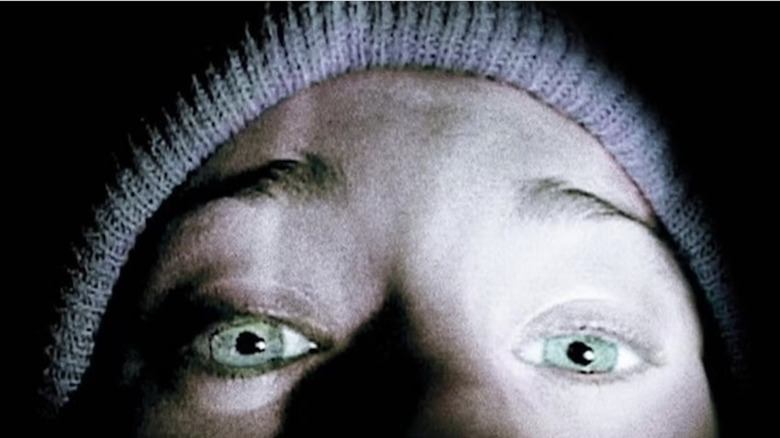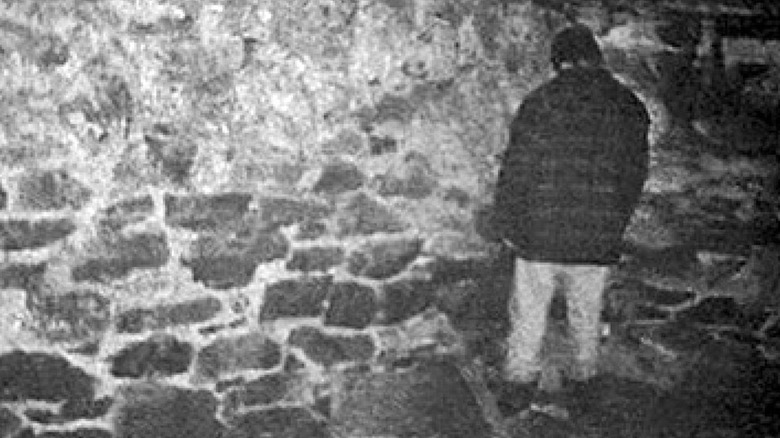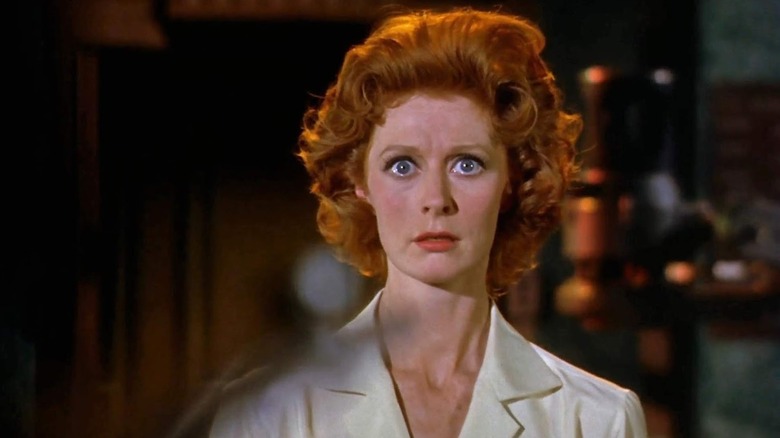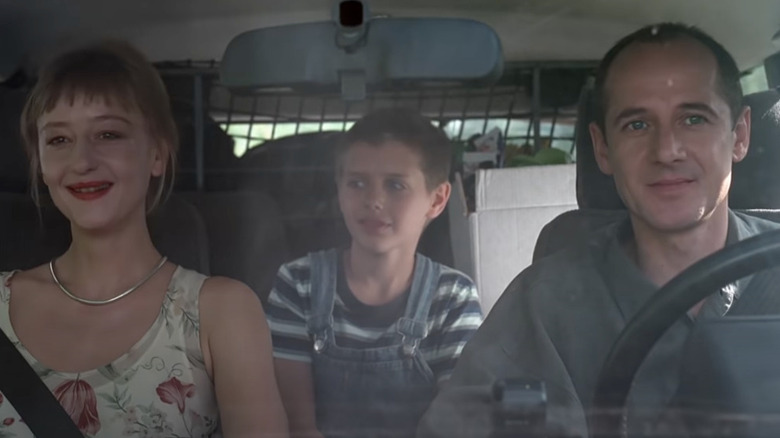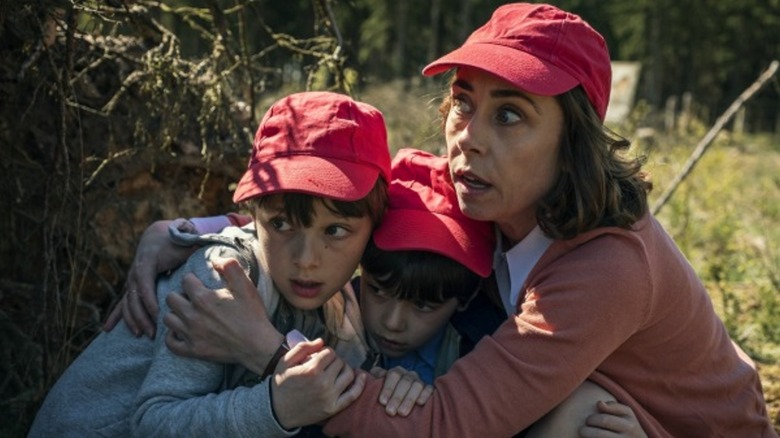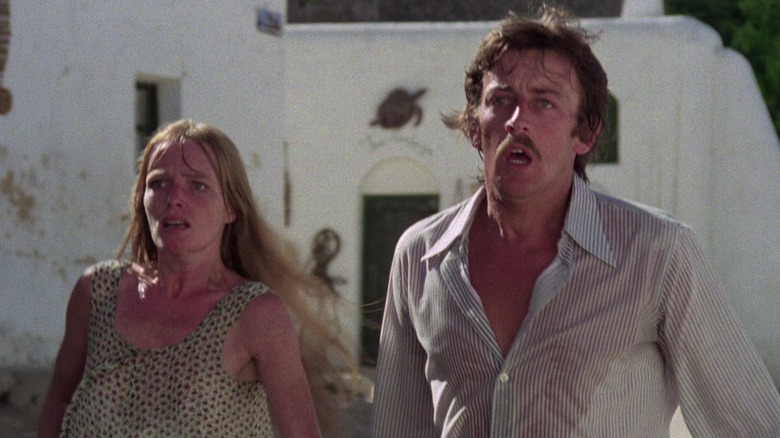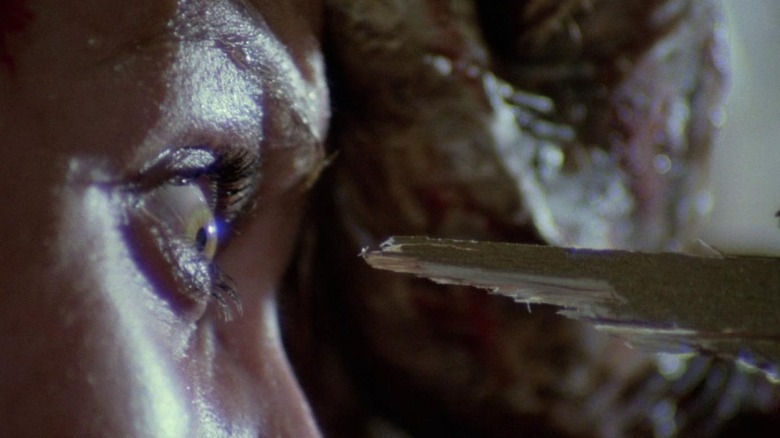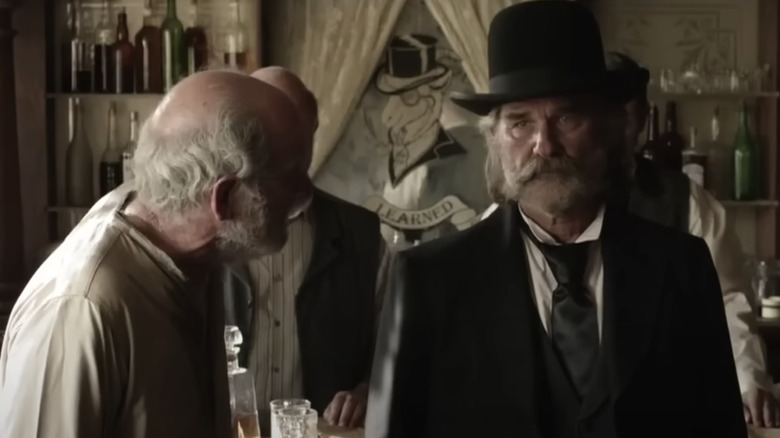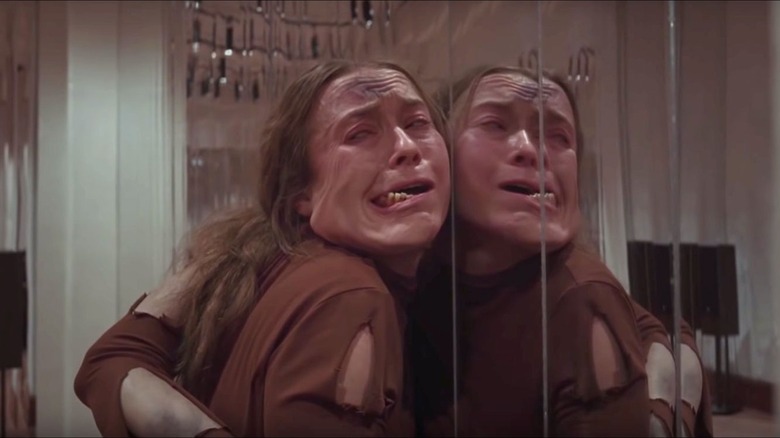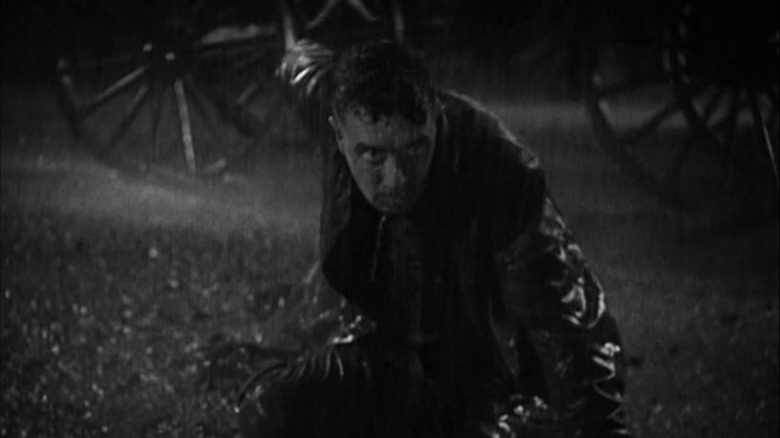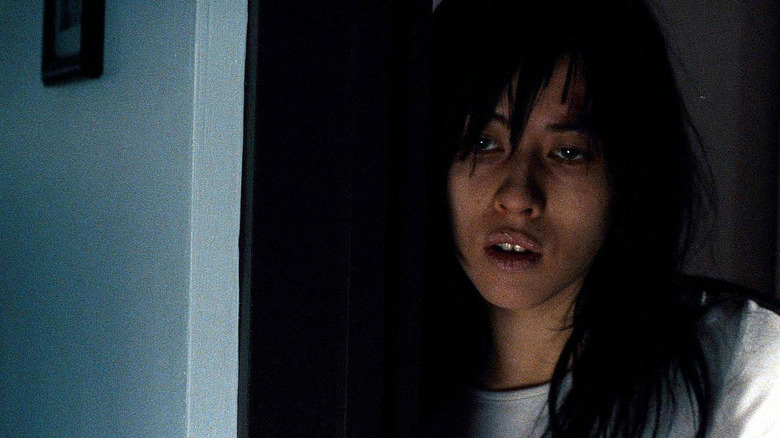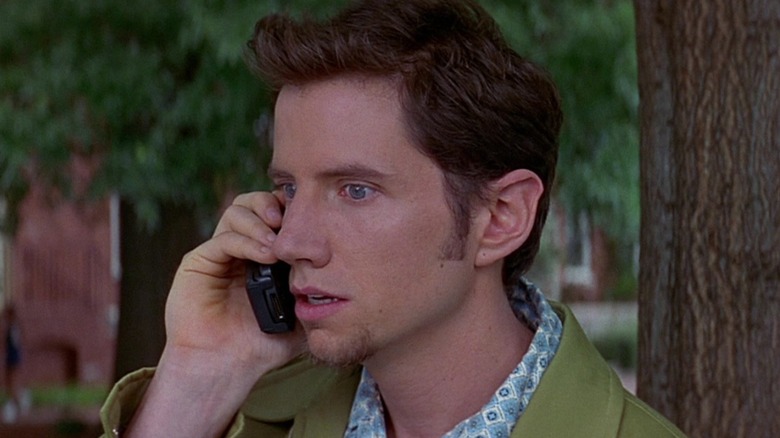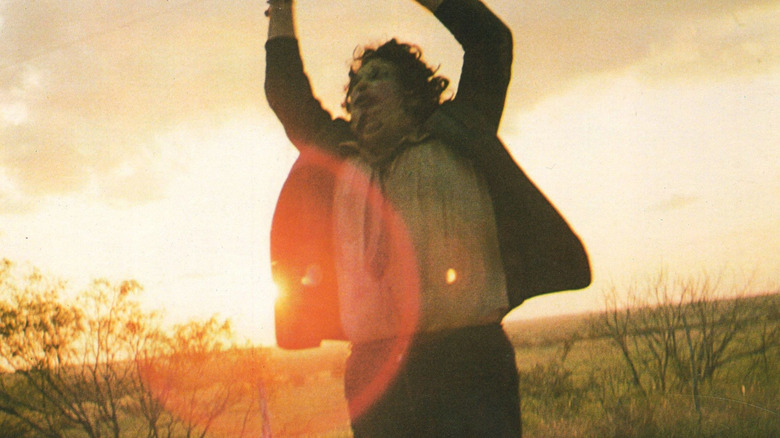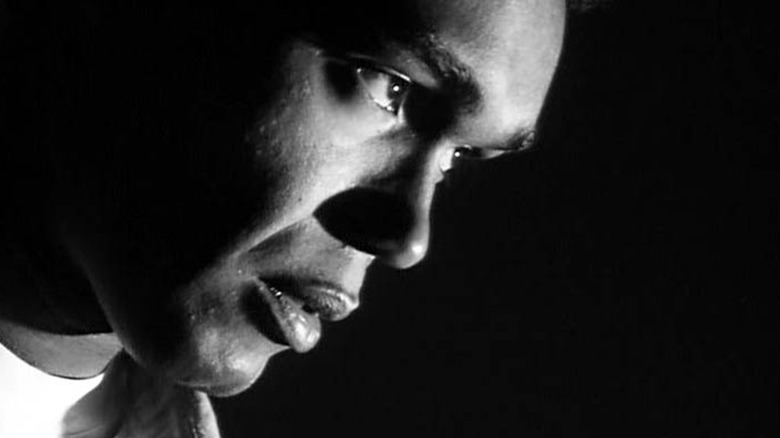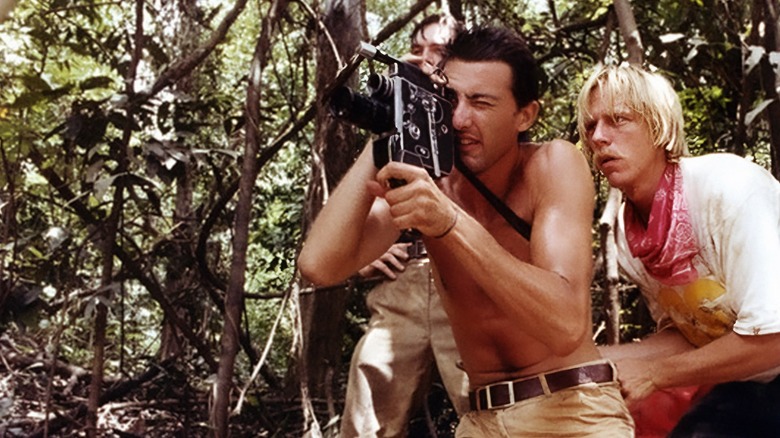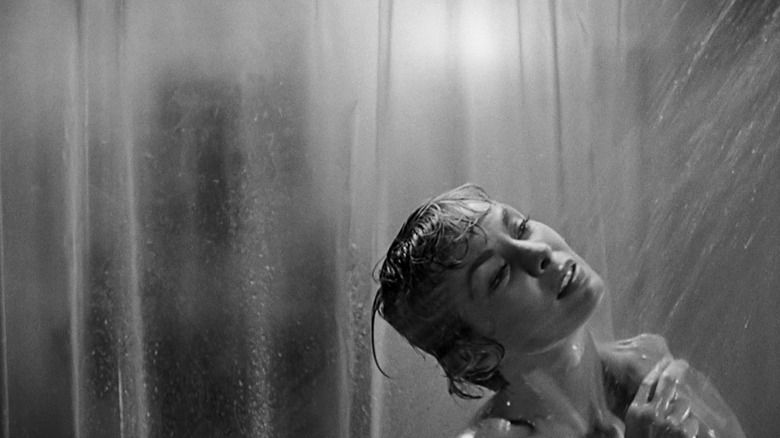The 15 Most Controversial Death Scenes In Horror Cinema
Horror films and controversy often go hand in hand. Historically, no genre has pushed the boundaries of what is acceptable onscreen as much as horror, with authorities like the MPAA and the BBFC constantly stepping in to protect filmgoers from extreme content.
Controversies abound in horror, with countless examples of censorship, intrusive cuts, or outright bans. Other times, films can provoke a visceral reaction from the audience; "Audition" prompted people to faint in the initial screenings, for example, while "The Exorcist" gained everlasting notoriety for the apparent hysteria it caused in cinemas.
Rather than a comprehensive list, this represents a broad spread of different types of controversial deaths in horror films. It might best be summed up as 14 of the most interesting controversial deaths, rather than necessarily all of the most obvious choices. As such, please take the order with a pinch of salt. Lots of spoilers below, so beware!
The Blair Witch Project
Mostly remembered today for single-handedly creating the found footage subgenre, "The Blair Witch Project" courted controversy by blurring the line between reality and fiction. Directors Daniel Myrick and Eduardo Sanchez played on the realism of the premise in the way they created the mythology of the fictional Blair Witch. Their inspired marketing campaign grounded the story in reality to the extent that some audiences believed it was a real documentary.
This extended to the filming itself, with the actors deliberately kept in the dark about their fates. Some of their frightened reactions were genuine, causing real distress and tension between the cast and crew, which only added to the film's veracity.
The final sequence plays on the mental exhaustion of the two remaining actors, with their characters drawn to an abandoned cabin in the woods by the cries of their missing friend. Heather (Heather Donahue) runs down to the cellar to discover Mike (Michael Williams) standing in the corner, in a recreation of past victims of the witch, before she is attacked herself, the camera dropping to the ground. It's a shocking, abrupt end to the film, and led audiences to think they'd really been killed. The families of the cast even received condolence messages from people.
Peeping Tom
Critics pilloried Michael Powell's "Peeping Tom" as morally reprehensible for forcing the audience to identify with a serial killer, even making them complicit in his murders. The main character, Mark (Carl Boehm), is a photographer who murders young women while filming them, capturing their final terrified facial expressions.
The murder of the dancer Vivian (Moira Shearer) might be the film's most upsetting scene, as the mood shifts suddenly from a carefree, light dance number to an intensely sinister tone. The look of dawning realization on Shearer's face as Mark advances on her remains unsettling today and would have been highly disturbing for its time.
"Peeping Tom" elicited incredibly negative reviews from contemporary critics who decried it as lurid and disgusting. It effectively ended Powell's directing career in the UK, forcing him to see out the remainder of his career in Australia. It's since experienced massive reappraisal, gaining credibility thanks to the effusive assessments of directors like Martin Scorsese, who praised the film for its voyeurism and the way it depicts filmmaking's obsessive grip on a creative mind. In 2022, he named "Peeping Tom" alongside Fellini's "8 1/2" as two films every director should watch.
Viewed today, it's a little starchy, even stilted, but there is something undeniably subversive about the film that helps it retain its status as a genre classic.
Funny Games
"Funny Games" is an incredibly uncomfortable film to watch, despite being described by writer-director Michael Haneke as "a self-reflexive anti-horror film." It follows a family held captive by a pair of disarmingly confident sociopaths who delight in playing childish games with them, often with fatal forfeits. However, the most controversial death occurs when Anna (Susanne Lothar) finally gains the upper hand, grabbing a shotgun and killing Peter (Frank Giering) with one shot.
No sooner does he hit the ground, though, than his accomplice Paul (Arno Frisch) picks up a remote control and rewinds the film — yes, the actual movie — to undo the shooting, completely erasing Anna's actions. That audacious move drew hostility from audiences who thought they finally saw a glimmer of light in the relentlessly fatalistic film, only for it to be cruelly snuffed out.
Haneke plays a cynical game of his own with the audience's expectations, compelling viewers to re-evaluate how we consume entertainment, especially horror films. Adding several fourth-wall-breaking looks to the camera, Haneke metatextually addresses the audience's complicity in the violence, in how we choose to watch scenes of horror. Haneke himself almost welcomed the backlash to his depiction of violence, saying: "anyone who leaves the cinema doesn't need the film, and anyone who stays does!"
The House That Jack Built
Lars Von Trier has never been one to shy away from controversy — indeed you could say he invites it, especially after his Hitler comments. His first outright horror film, "The House That Jack Built" may be his most controversial film yet, resulting in around 100 walkouts at the Cannes Film Festival, but also a standing ovation. One review called it "repulsive, toxic trash," while reportedly filmmaker Gaspar Noe couldn't stop laughing while watching it.
Following the eponymous Jack (Matt Dillon) over the course of 12 years, he recounts numerous encounters with women whom he invariably murders in truly horrific ways. In the most controversial scene, Jack goes hunting with his new girlfriend (Sofie Grabol) and her two sons, only to ruthlessly hunt them down. Von Trier doesn't spare the audience in his depiction of the killings, and his dispassionate camera reflects the cold-blooded nature of his protagonist, showing the deaths in graphic detail. Jack then forces their mother to have a picnic with their corpses, before killing her too.
"The House That Jack Built" is a truly difficult film to sit through, with some moments that are stomach-churning, and others that are darkly comic. It's a controversial film to be sure, but it's a calculated kind of controversy, where you get the distinct feeling Von Trier simply made the film to upset people. He has been quoted as saying "I'm not sure they hated it enough" which tells you all you need to know.
Who Can Kill a Child?
One of the most bonkers premises for a horror film, Narciso Ibanez Serrador's "Who Can Kill A Child?" follows Tom (Lewis Fiander) and Evelyn (Prunella Ransome) a young couple with a baby on the way, who take a relaxing vacation. Staying on a remote Spanish island, they slowly discover something very sinister about the island, where some unseen force compels the children to kill every adult who crosses their path.
The death of Evelyn is the most upsetting in the film as after allowing a child to touch her pregnant stomach, her fetus begins killing her from the inside. It's not a particularly gory scene, but it's incredibly disturbing, and the horror is vividly portrayed by Ransome. This proved disturbing enough to get the film heavily censored upon its release.
"Who Can Kill A Child?" might be one of the lesser-known films on this list, but its dark unsettling atmosphere makes it a unique addition. It's not the violence itself that's controversial, but the macabre idea of children committing these crimes. It recalls the ending of Mario Bava's "A Bay Of Blood," where the children treat the film's murders as a game, and cheerfully join in, killing their parents.
Zombie Flesh Eaters
The Video Nasties saga of the 1970s meant that films that otherwise might have passed audiences by, were granted a newfound notoriety thanks to being banned. Lucio Fulci had three films on the Video Nasties list – more than any other director. His style is an acquired taste for sure, with mood a lot more important than logic — there are an awful lot of scenes where victims just stand completely still and allow themselves to be killed. But there's no denying the hypnotic effect.
"Zombie Flesh Eaters" has plenty of stomach-churning moments, (also a zombie punching a shark) but most famous of all is the scene where Paola (Olga Karlatos) is grabbed, and her face is slowly, inexorably pulled towards a jagged splinter of wood conveniently positioned just at eye level. Just when you think Fulci will cut away, he shows the splinter slowly puncture her eyeball. It's a prolonged, agonizing sequence, and while the rest of the film is a little risible today, this sequence is still horrific, and honestly, you can understand the BBFC's decision.
In the 1970s, this scene in particular drove the censors mad and was edited way down by the BBFC. The film wasn't fully released in its intact form until 2005 when all the gore was finally restored in all its glory.
Bone Tomahawk
You know a death scene is going to be controversial when your research leads to endless discussions of "That Scene". Unlike many similarly hyped-up scenes, this one truly delivers. It's grisly, graphic, and realistic, and considering the relative quaintness of the film up to this point it really comes out of nowhere.
When a group of townspeople are abducted from his quiet little town, Sheriff Hunt (Kurt Russell) leads a rescue mission to bring them back. The expedition brings him face to face with a monstrous, barbaric tribe of "Troglodytes" who take him captive, and in a horrific scene, bisect and dismember his loyal deputy, Nick (Evan Jonigkeit) in front of him.
This may well be the most viscerally horrific death scene ever committed to film. Without this scene, the film may have faded into undeserved obscurity as one of those underrated modern Westerns like "Appaloosa," "Open Range," or "Seraphim Falls." With it, the film gained attention and notoriety which drew attention to S Craig Zahler's wonderful script and the perfectly judged performances.
Many argued that this scene was gratuitous and crossed a line in terms of violence, and it's true that it's an incredibly tough watch. What really sells the horror though, is Russell's utterly numbed reaction. By the end of the sequence, he is just bereft of any kind of hope, and Russell conveys this without any hysterics, he just visibly deflates.
Suspiria
Luca Guadagnino's remake of Dario Argento's classic proved controversial in a number of ways, primarily for having the audacity to tackle one of the all-time unique horror films in the first place! However, it really gained notoriety for the particularly gruesome death of Olga (Elena Fokina).
After decrying a dance school as being run by witches, Olga attempts to leave, only to find herself trapped in a dance hall. The coven's revenge is swift, as they use magic to link Olga to Suzy (Dakota Johnson), who is beginning her dance routine. Olga is thrown around in a grotesque mockery of Suzy's beautiful choreography. Powerless to protect herself, Olga's body contorts and breaks, her muscles distending and bones protruding. It's a truly disturbing scene, made worse by Olga losing control of her bodily functions and the bone-crunching sound design.
The worst thing is how at the end of all of this, she doesn't even die. She's just a twisted, broken mass of bones and muscles, eventually moved out of the hall by witches brandishing meat hooks. She survives in that state until the very end of the film when she is finally, mercifully put out of her misery. Amazon even marketed the film on the basis of this viscerally nasty scene, filming viewers and their horrified reactions.
Freaks
Director Tod Browning was way ahead of his time in depicting sideshow acts as fully fleshed-out, sympathetic characters for most of "Freaks." However, in the film's climax, he relies on the more sensationalist preconceptions of the freaks of the title, where they take their revenge on the couple who have been poisoning one of their group.
The murder of circus strongman Hercules is perhaps the most controversial scene, as the vengeful performers pursue him through the rain, brandishing knives and straight razors. In the film's existing form, he is killed offscreen, but in the original cut, his fate is even nastier. Deleted scenes, now lost forever, heavily implied that he was castrated, as evidenced by a scene showing him now singing in a chilling falsetto.
The film in its original cut was so controversial that an audience member at a test screening threatened to sue MGM for causing her miscarriage. It was eviscerated by critics, with one reviewer predicting the oncoming production code in his review, saying: "In Freaks the movies make their great step toward national censorship. If they get it, they will have no one to blame but themselves."
As a pre-code film, "Freaks" could get away with nastier scenes than those made in the Golden Age. However, it still faced censorship and was banned in some regions, including the UK, where it only became available in 1963. It had ramifications as well for Browning, whose career never recovered.
Martyrs
A philosophical, existential rumination on mortality and religion, "Martyrs" pushes the boundaries of what is acceptable in film. Whatever thought-provoking message it contains, though, the relentless and visceral depiction of violence led many to dismiss it as simply exploitative and gratuitously violent.
The treatment of Anna seems particularly cruel. Established as a strong-willed young woman, this makes her torture and character breakdown at the hands of a religious cult all the more disturbing. Determined to prove the existence of the afterlife, the cult's method is to "martyr" a young woman, by torturing her to the point of death, where she will supposedly receive a beatific vision that will verify the existence of the afterlife.
Anna, their latest victim, withstands most of the torture thrown her way until she reaches the final stage, where she is flayed alive. It's a horrific scene, but in the end, she retains enough of her previous resilience to take her revenge on her killers (or at least that's one interpretation of the enigmatic ending). It's an unflinching death scene, but there is a point to it. "Martyrs" has gained a reputation as a horrific film, part of the "New French Extremity" movement that stretches the envelope in terms of extreme violence and gore. It's actually more intellectual and less sensationalist than you might think but that didn't stop audiences from walking out of numerous festival screenings, including its premiere at Cannes.
Scream 2
Fans of the first "Scream" voiced outrage at the death of fan-favorite Randy Meeks (Jamie Kennedy), the self-appointed arbiter of horror film rules, in the sequel. His death scene is unnerving in several ways. The fact it happens in broad daylight in an open space feels like a violation in itself (as well as a nod to a similar scene in Dario Argento's "Tenebrae"), and Randy was one of the core cast, arguably the most likable of the bunch, and certainly, the one most movie geeks identified with.
Killing him off halfway through the sequel was a bold narrative choice, and it's especially upsetting that his demise comes just after his finest moment in the series, telling Ghost-face exactly what he thinks of him. Unlike the death of Dewey in the rebooted "Scream," Randy's death isn't signposted at all; it's a genuine gut punch that nonetheless shows why sometimes it's necessary to kill your best characters.
To this day, Kennedy is stopped on the street by fans annoyed that Randy died too early, while "Scream" screenwriter Kevin Williamson admitted that he regrets killing off Randy and that he wouldn't have done it if he had realized just how popular the series would become. Williamson and Wes Craven implicitly addressed this error in subsequent installments, including a pre-recorded video of Randy in "Scream 3" and his niece Mindy (Jasmin Savoy Brown) appearing as a surrogate version of the character in the reboots.
The Texas Chain Saw Massacre
Banned in the UK for 23 years, you could be forgiven for thinking that "The Texas Chain Saw Massacre" would be as gory as its title suggests. You might be surprised, then, by the clinical restraint shown by director Tobe Hooper in the death scenes (all five of them!). Indeed, Hooper originally intended the film to receive a PG rating, arguing that only one character actually dies by chainsaw.
What makes the film so disconcerting today is the sudden, offhand execution of the death scenes. Perhaps the most notorious of these is that of easy-going Pam (Teri McMinn). Known now as "The meat-hook scene," this sequence caused a stir at the time due to the perceived gore, as Pam is seized by the imposing Leatherface (Gunnar Hansen), who effortlessly carries her to the slaughterhouse, where he unceremoniously hangs her on a meat-hook. Despite the nastiness of the scene, the unpleasantness is all achieved through editing and the power of suggestion, although this didn't stop audiences from walking out in outrage.
Ironically it was the lack of gore that caused more problems for the film, at least in the UK, where the BBFC decided that the tone was so intense, and the scene so carefully edited, that cutting it down any more wouldn't make the film any less nasty. It remained unavailable in the UK until 1999.
Night of the Living Dead
George A. Romero never skimped on social commentary, especially in his "Dead" films. He maintained that the casting of an African-American actor in the lead role in "Night of the Living Dead" simply boiled down to Duane Jones being the best actor for the part, and it's true that Jones gives a commanding performance as Ben, the story's lone level-headed character. However, considering the social context of when the film was made, it's impossible to ignore the parallels between the race relations at the time and the treatment of Ben throughout the movie, and his death in the final scene is the best example of this.
In a bitter irony, after emerging as the sole survivor having defended the farmhouse from the onslaught of zombies, Ben emerges from the shadows, only to be unceremoniously shot by a group of redneck hunters who mistake him for a zombie. The subsequent newsreel-style footage that plays over the end credits is really uncomfortable, even today. The imagery of Ben's body being dragged along by meat hooks and flung onto a pyre recalls real-life photographs of lynchings in the U.S. The 1960s civil rights movement was still very topical and this treatment of one of the few black protagonists as somehow less than human by the overwhelmingly white mob of hunters held up a mirror to societal problems in America, whether Romero intended this or not.
Cannibal Holocaust
The multiple real animals slaughtered for "Cannibal Holocaust" make it a film I'm never going to watch again. However, this list is about controversial films and any film that ends up with the director being actually arrested and brought up on murder charges definitely fulfills the brief.
Ruggero Deodato shot his film with such documentary realism that he was accused of actually murdering his cast and needed to produce them in court to prove that they were still alive. This was an unintended side effect of Deodato's plan for verisimilitude, though, as he added temporary disappearance clauses to his actors' contracts where they had to agree to lie low for a year after filming ended.
There is a subversive symmetry to Deodato's filmmaking and the story he tells, where he depicts exploitative filmmakers manipulating reality to fit their own narrative while making his own exploitation film. None of the characters in the original film crew are sympathetic, and they are shown to be responsible for many of the film's most barbaric acts. In perhaps the nastiest human death, the crew rapes a Ya̧nomamö girl, only to later discover her body, impaled on a huge wooden pole (an incredibly realistic effect, accomplished with a bike seat on a pole). It's strongly suggested that the camera crew bears responsibility for her death, given how they are shown smirking when they observe her corpse.
Psycho
One of the most famous film scenes of all time, the shower scene in "Psycho" might be the most important controversial death in horror cinema.
This scene set the standard for killing off the main character halfway through the film, something that has been replicated in countless films since, but never with the same impact. Janet Leigh was arguably the biggest star in the film at that point (Anthony Perkins' star was on the rise, for sure, but "Psycho" put him on the map) and it's still jarring today watching the audience identification figure get murdered, even when you know it's coming. At the time of its release, it caused genuine hysteria in audiences, who reportedly ran for the doors and fainted in their seats. It was banned in several countries, and heavily edited for release in the UK.
Aside from that, the sheer amount of violence in the scene is still genuinely upsetting, especially considering the shower setting, with Leigh's character at her most vulnerable. Many audience members at the time swore that they saw the knife actually stabbing Leigh, but there isn't a single frame showing the knife going in (despite what some eagle-eyed viewers might think). Instead, director Alfred Hitchcock achieved the effect through some incredibly fast-paced editing, and that iconic, piercing Bernard Hermann score.
